|
Five of these 60-foot diameter parabolic antennas were built by Professor Ron Bracewell at Stanford University some forty years ago. Long since orphaned and slated for destruction, they became a cause celebre among amateur radio astronomers striving to rescue them. See this editorial by Dr. Bob Lash, who heads Friends of the Bracewell Observatory, a collaborative effort of The SETI League, the Society of Amateur Radio Astronomers, the Society of Amateur Scientists, and others.
Bob Lash photo |
 25 December 2004 |
|
David HM Spector, W2DHM, is making progress with his Project Argus station on Long Island, NY. Seen in this 72" rack are his Icom-R8500 0.1MHz-2GHz all mode receiver; Intel ISP-2150 rack-mount server running Linux with two 800MHz Pentium III coppermine processors, 512MB ECC DRAM, one 18GB 10,000rpm boot drive, two 36GB 10,000rpm disks as a striped RAID-0 set for data storage for the SETI data, Soundblaster-PCI sound card as DSP, and Hewlett-Packard Procurve-2425 100Mbit Ethernet switch (connects the ham-shack computers to the main house network). Outside, David has a 10' KTI TVRO Dish with RAS SETI Feed-horn and Choke-Ring, and a Comet 25MHz-2GHz discone used for general purpose reception with the IC-R8500. Click here for more pictures of David's station.
W2DHM photo |
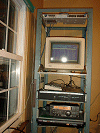 4 December 2004 |
|
The Invitation to ETI unveiled its new website last week. This innovative SETI program headed by SETI League member Prof. Allen Tough seeks to establish dialog with technologically advanced extraterrestrial entities through its extensive internet presence. Emphasis at ieti.org is accessibility, since the site is targeted at an audience with whom we humans may have nothing biological in common. See this Press Release for further details.
Invitation to ETI image |
 27 November 2004 |
|
Last month, during the International Astronautical Congress, nine members of the Invitation to ETI group (five of whom are SETI League members) met at a local Vancouver restaurant for lunch and lively discussion.
SETI League photo |
 20 November 2004 |
|
 13 November 2004 |
|
Detail of the two 24 inch linear actuator arms, used at Project Argus station JM55ht for declination and right ascension adjustment.
Hamdi Mani photo |
 30 October 2004 |
|
In Tunisia, Hamdi Mani sets a good example by wearing safety equipment when working on the antenna at Project Argus station JM55ht. A close look at his hard hat reveals that it sports a SETI League logo.
Hamdi Mani photo |
 23 October 2004 |
|
Two weeks ago, these six SETI League members were among the more than 2,000 space enthusiasts participating in the International Astronautical Congress in Vancouver Canada. They are all members of the SETI Permanent Study Group of the International Academy of Astronautics.
SETI League photo |
 16 October 2004 |
|
SETI League members in Washington DC this week for the International Space Symposium sponsored by our sister organization, the Radio Amateur Satellite Corporation (AMSAT), got a treat when visiting the nearby Smithsonian Institution. This small satellite, the actual full-size Microsat mechanical test model, was recently put on display in the Information Age exhibit at the National Museum of American History. AMSAT volunteers built it for use in vibration tests in the U.S. and at the European Space Agency's Ariane launch facility in Kourou, French Guyana.
W3PK photo |
 9 October 2004 |
|
 2 October 2004 |
|
The first radio telescope in Tunisia is slowly taking shape, and it is a Project Argus station! Regional coordinator Hamdi Mani has his three-meter diameter mesh dish mounted with two 24 inch linear actuator arms for azimuth-elevation tracking, and is now working on getting the electronics installed. He writes, "a radio telescope is really a good project for high school students. I will try to convince the ministry of education of my country to include this kind of project in the schools and colleges."
Hamdi Mani photo |
 25 September 2004 |
|
At last month's SETICon, the editors of Contact In Context honored The SETI League website, presenting special Best Ideas Awards to SETI League founder Richard Factor (left), and webmaster H. Paul Shuch (right), for "providing a wide-ranging forum for creative, innovative, and controversial ideas. Such a forum, free from ultraconservative prejudice and subtle censorship, is especially important in the SETI field -- a field that clearly needs fresh ideas and voices."
SETI League photo |
 18 September 2004 |
|
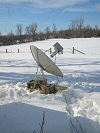 11 September 2004 |
|
 4 September 2004 |
|
For the fourth year in a row, every attendee went home from our recent SETICon with a door prize. First Prize, a 1420 MHz weak signal source kit donated by Down East Microwave Inc., went to Marko Cebokli (right). Allen Tough (left) won the Grand Prize, a 1420 MHz helical antenna feed contributed by Olde Antenna Labs of Denver CO.
SETI League photo |
 28 August 2004 |
|
Last weekend, new member George Raynault and his wife Melanie hosted a dozen SETI enthusiasts at their home just outside of Toronto, for an afternoon of freewheeling, speculative discussion. We thank George for his enthusiasm, energy and encouragement.
Gloria Rong photo |
 21 August 2004 |
|
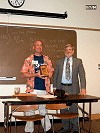 14 August 2004 |
|
 7 August 2004 |
|
 31 July 2004 |
|
 24 July 2004 |
|
 17 July 2004 |
|
 10 July 2004 |
|
 3 July 2004 |
|
 26 June 2004 |
|
 19 June 2004 |
|
 12 June 2004 |
|
 5 June 2004 |
|
This rectangular waveguide horn antenna was designed by Dick Knadle, K2RIW and built by Jeff Lichtman, founder of the Society of Amateur Radio Astronomers, for HEP research in the late 1980s. The cavity was designed to dimensions provided by Fred Crews of NRAO Green Bank WV. At 29 by 29 inches of aperture by four feet in length, this design performs on a par with the later SETI Horn of Plenty.
Radio Astronomy Supplies photo |
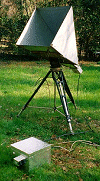 29 May 2004 |
|
 22 May 2004 |
|  15 May 2004 |
|
 8 May 2004 |
|
 1 May 2004 |
|
Attendees at last month's EuroSETI04 Science and Technology Workshop visited Peter Wright's radio telescope in Mannheim, Germany. Here Peter shows off his innovative hinged feed-arm design, used for quickly changing bands on his three meter dish. For further technical details, click for a virtual tour of the Mannheim Radio Telescope.
SETI League photo |
 24 April 2004 |
|
Most Project Argus stations start out when members acquire a surplus C-band satellite TV dish. This one, which seems to have fallen off its mount, is apparently no longer receiving video (or maybe the signal is just a bit snowy), so might be a good candidate for acquisition. Members have found that such derelict dishes are generally available for the asking, and can be readily repurposed into sensitive L-band radio telescopes.
Devin Bailey photo |
 17 April 2004 |
|
Last month's EuroSETI04 Science and Technology Workshop drew 15 SETI League members from the US, Scotland, Germany, France, Italy, Switzerland, Luxembourg, and Russia. Additional photos are available here. The next such meeting is being scheduled to coincide with SETICon06, is planned for 8-10 September, 2006, and will again be held at the Starkenburg Observatory, Heppenheim Germany.
SETI League photo |
 10 April 2004 |
|
Stelio Montebugnoli, who heads the SETI Italia project from the Medecina radio telescopes in Italy, was honored last week at EuroSETI04, The SETI League's first European SETI Science and Technology Workshop, with the annual Giordano Bruno Memorial Award, for significant contributions to SETI science. See this Press Release for details.
SETI League photo |
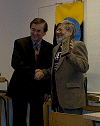 3 April 2004 |
|
Marcus Leech, VE3MDL, built this helical dish feed for 1420 MHz from exotic materials. He writes, "I combined my two hobbies, in that the form for the helix is standard paper 2.6 inch airframe tubing for high-powered model rockets. You can get this in fibreglass and a pultruded material called 'quantum tube'. It turns out that 2.65 inch OD is a near-perfect size for winding a helix with a 1420.405 Mhz center frequency. Serendipitous!"
VE3MDL photo |
 27 March 2004 |
|
 20 March 2004 |
|
Several years ago, member David Fahey developed a control program for the Icom IC-R8500 receiver. At right is the virtual front panel produced by that program. The Object Pascal source code and Windows executable are available for download.
David Fahey image |
13 March 2004 |
|  6 March 2004 |
|
 28 February 2004 |
|
Last autumn, the European Radio Astronomy Club voted its highest honor, the DSP-FFT Award, to SETI League president Richard Factor, for his efforts to promote amateur radio astronomy in Europe (see this Press Release). Some weeks after returning from the European Radio Astronomy Congress in Germany, executive director H. Paul Shuch had an opportunity to present Factor with his award plaque.
SETI League photo |
 21 February 2004 |
|
14 February 2004 |
|
Rob Lodder, WD8BTA, built this ten-foot dish for SETI observations from Argus station EM77to in Lexington KY, USA. Executive director H. Paul Shuch stopped by Lodder's station last summer, while enroute to the Central States VHF Conference in Oklahoma.
SETI League photo |
 7 February 2004 |
|
Tommy Henderson, WD5AGO, shows off two horn antennas used for radio astronomy. The larger of the two (on an az-el mount) is optimized for 1.4 GHz hydrogen line observations. Tommy is holding a smaller horn for 5.7 GHz methanol line measurements. Executive director H. Paul Shuch had an opportunity to visit Henderson's station during last summer's Central States VHF Conference in Oklahoma.
SETI League photo |
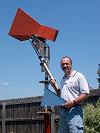 31 January 2004 |
|
Left to right: Professors Allen Tough and Rob Lodder present Contact In Context Best Ideas Awards to authors Scot Stride and Dr. Bruce Cornet, at last April's annual SETI League Awards Banquet.. Other publication award winners not present included Dr. Steve Dick, Prof. Chandra Wickramasinghe, Stephen Webb, and Dr. John R. Rice. See this Press Release.
SETI League photo |
 24 January 2004 |
|
 17 January 2004 |
|
 10 January 2004 |
|
 3 January 2004 |
Click here for lots more pictures.
email the Webmaster | entire website copyright © The SETI League, Inc.; Maintained by Microcomm this page last updated 25 December 2004 |
Top of Page |
 SETI League Photo Gallery
SETI League Photo Gallery

